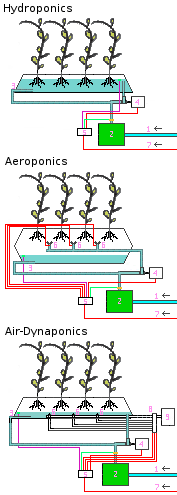Hydroponics allow to grow plants indoors (e.g. in a greenhouse), hence allowing to grow crops that may not be cultivated outdoors in the region where you live. In addition, it also provides nutrients together with the water, avoiding the need for separately fertilising the plants. Also, yields are up to 4x greater than with tradional soil-based growing, and less water is used.
- Aeroponics
- Air-dynaponics
Types[edit | edit source]

Regular hydroponics is often operated using NFT (Nutrient Film Technique). This uses a shallow (film) of nutrients; about 1-2mm deep. Flat-bottom rain gutters can be used as growing channels.
Regular drip lines can be a low-cost/uncomplicated alternative if you do not require the advantages of a hydroponics system and just wish to use a system to water your plants indoors. Fertilisation can then be done manually.
Non-circulating hydroponics[edit | edit source]
Lettuce can be grown hydroponically without electricity and pumps.[1][2] After planting, no additional labor is required until harvesting.[1]
From the University of Hawaii's agricultural research center:
"Plants are automatically watered, because the entire growing medium in the net pot becomes moistened by capillary action. Plant growth causes the nutrient solution level to decrease, thus creating an expanding moist air space which is maintained, because the tank cover prevents roots from drying. At some point, direct capillary wetting of the substrate is no longer possible, but the expanding root system is capable of absorbing nutrient solution from the tank. Roots occupying the moist air space above the solution have been described as oxygen roots whose main function is aeration..."[1]
Making the nutrient solution[edit | edit source]
One of the main difficulties with X-ponics systems is how to obtain the nutrient solution. In developing contexts, these may be difficult to come by, and are often also too expensive for most people in the developed world. However, the nutrient solution can also be made DIY using either liquid fertiliser of a wormery ("worm tea") or from comfrey concentrate/tea.[3]
References[edit | edit source]
See also[edit | edit source]
External links[edit | edit source]
- http://en.wikipedia.org/wiki/Hydroponics
- http://en.wikipedia.org/wiki/Aeroponics
- http://www.cityfarmer.org/singaporeroof.html
- http://web.archive.org/web/20200808052951/http://www.growingedge.com/magazine/back_issues/view_article.php3?AID=160172
- http://web.archive.org/web/20170521024614/http://www.np.edu.sg:80/lsct/aboutus/staff/Pages/ckk.aspx
- http://www.biocontrols.com/aero18b.htm
- http://alfin2100.blogspot.com/2010/04/no-cropland-no-problem-farming-on-air.html
- http://opensourceecology.org/wiki/Hydroponics
- http://hmeter.sourceforge.net/
- http://web.archive.org/web/20130218134616/http://scienceinhydroponics.com:80/2011/01/the-first-free-hydroponic-nutrient-calculator-program-o.html